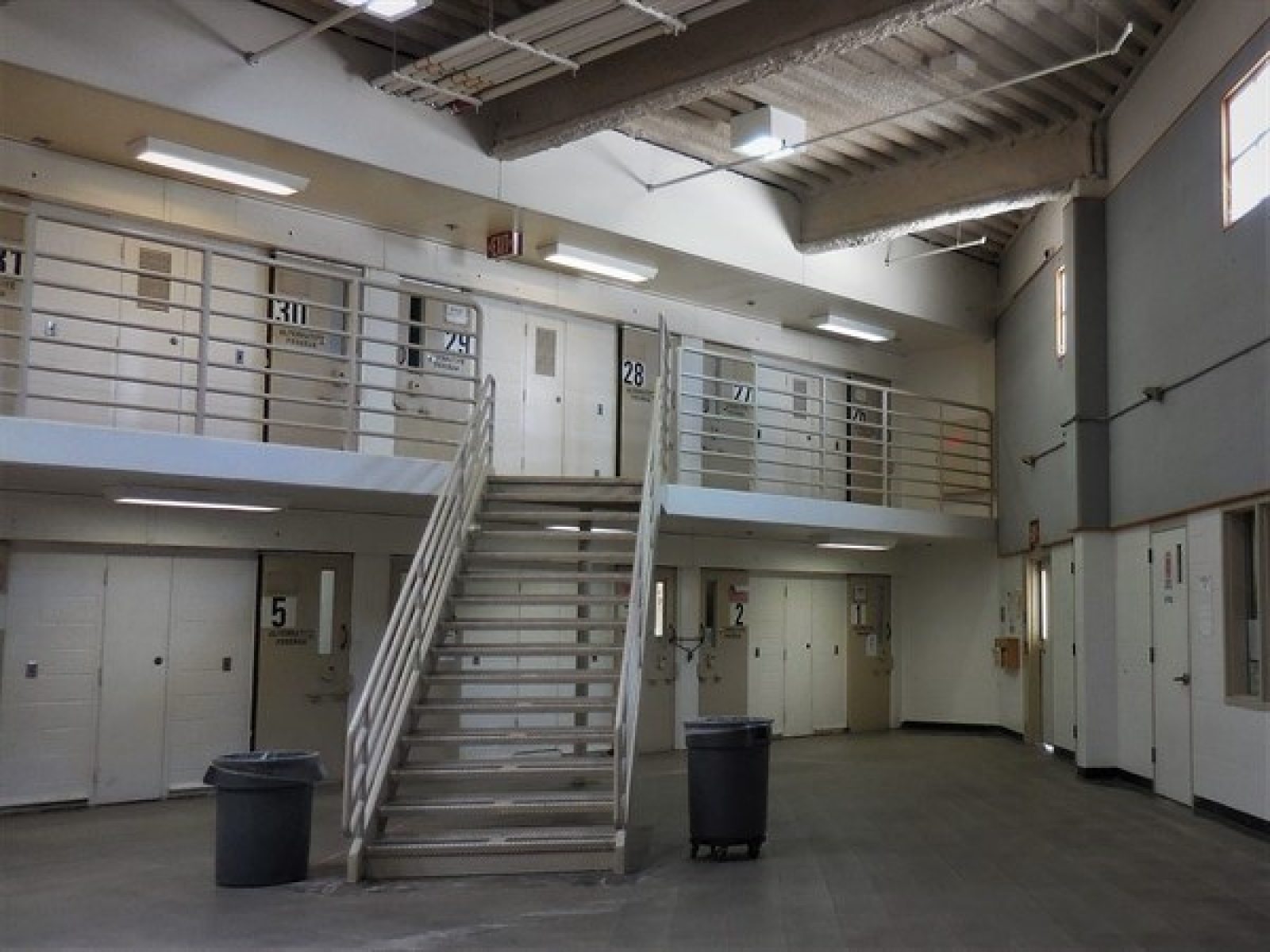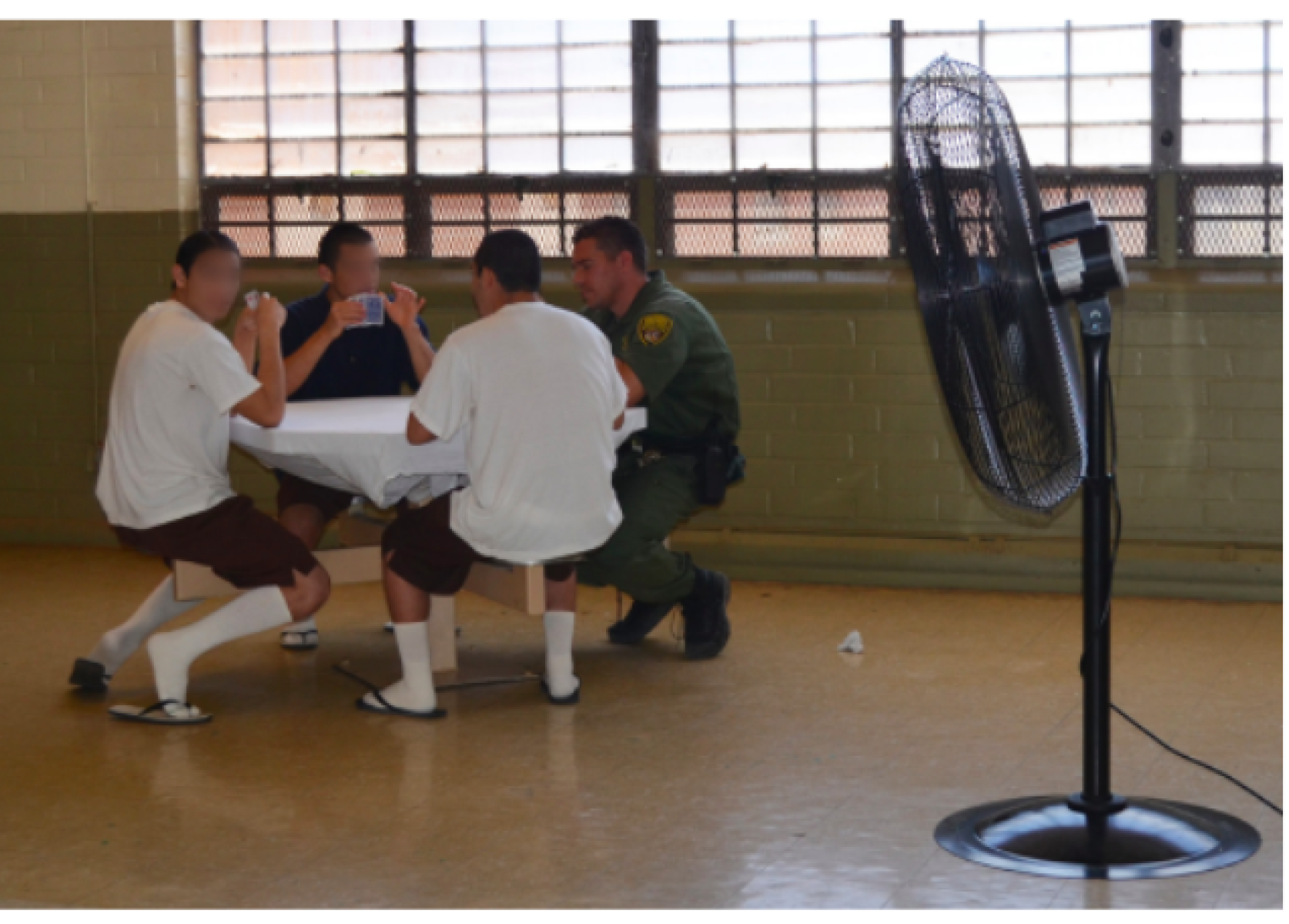Photo taken by CJCJ of California Division of Juvenile Justice (DJJ) juvenile facility housing unit.
Over the past couple of decades, there has been a noticeable increase in public discourse concerning juvenile incarceration and its negative impacts. This is largely due to heightened awareness fueled by advocacy efforts, media coverage, and a growing understanding of the flaws in punitive approaches to youth justice. In some areas, these conversations led to a decline in youth incarceration rates. For instance, in Illinois, Cook County’s Juvenile Temporary Detention Center, which once confined up to 800 children in the early 2000s, now holds 300 – 350 children a day in a 498-bed facility. This mirrors declining youth incarceration trends across the county.
Despite these falling numbers, the US still incarcerates more young people than any other nation. This underscores the persistent reliance on punitive measures over rehabilitative approaches in addressing youth justice issues. Up until recently, many juvenile justice policies negatively impacted youth’s lives.
The “War on Drugs,” initiated in the 1970s, and the concurrent “tough on crime” approach have significantly contributed to the lingering problem of youth incarceration by imposing stricter sentencing policies in place. Currently, 46 states and the District of Columbia enforce transfer laws allowing youths to be tried as adults in adult courts. This practice, even for non-violent offenses, has far-reaching consequences on a young person’s future, irrespective of whether they are ultimately convicted. Such laws hinder youth development and elevate the risk of recidivism.
In 1995, the “Super Predator” narrative, coined by Princeton University’s John Dilulio, painted a dire picture of juveniles as a “new breed of offenders” devoid of respect for human life — a notion that has since been debunked. Dilulio’s prediction of a surge in juvenile predators lacked evidence. However, his narrative led to increased police surveillance and stricter policies for young individuals.
This overarching theme of “Super Predator” reflects a deterrence-based model that reached its peak in the 1970s, aligning with the onset of the “War on Drugs” campaign. History has shown that deterrence, while it may have harmful effects on an individual’s future, does little to address the root causes of juvenile delinquency. The negative effect of a young person being labeled as a criminal and the lasting consequences of punitive systems only exacerbates the need for rehabilitation.
It is imperative to recognize the detrimental impact of incarceration on young people’s health and well-being. Research conducted by the Sentencing Project highlights that young individuals, often from marginalized communities, entering detention and correctional facilities are disproportionately burdened with serious health challenges. They are more likely to grapple with mental health issues such as depression, PTSD, and active suicidal ideation. Incarceration in juvenile facilities throughout the US often makes these issues increasingly worse through practices of isolation, neglect, and a lack of rehabilitative support.
Despite cultural differences, the detrimental effects of punitive measures on young individuals remain consistent.
The harmful effects of the punitive narrative extends beyond the borders of developed nations, as evidenced by my research at the Youth Offenders Industrial School (YOIS) in Karachi, Pakistan. YOIS is one of the youth jails in Karachi (Sindh). This research site is strictly limited to boys aged sixteen to eighteen who, at that time of the field work, were detained at YOIS. This research mainly discussed the ways in which selected youth serving their sentence at YOIS, experience their predicament as youth “offenders” (as they’re commonly referred to) and how they perceive their preparedness for release, considering the support provided through the facilities and services of the detention school. Understanding the rehabilitation process of youth is crucial to improve the effectiveness of correctional services and ensure lower recidivism rates. This project therefore also examined the rehabilitation programs and services offered at YOIS in conjunction with those offered through local NGOs.
Despite cultural differences, the detrimental effects of punitive measures on young individuals remain consistent. In my research, the emphasis was placed on how rehabilitation services equip young boys (aged 16 — 18) to move away from a life of crime, and make better life decisions, once released. In my research, I spoke with many youth at YOIS, who shared their emotions and feelings while being there. The youth expressed that anger was one of their most potent emotions. They felt anger and outrage, primarily towards their family members, friends and even law enforcement. They felt betrayal and abandonment by their loved ones, and also by the system, for being unfairly treated or accused.
Youth at YOIS need mental health support to create healthy boundaries and navigate their emotions. During my interview with a clinical psychologist at YOIS on the youth she worked with inside the facility, she expressed, “They [youth detainees] are not able to trust people because their trust has been broken already. The hurt is manifested in terms of aggression and anger towards people”. For this purpose, mental health counseling and groups are an important part of rehabilitation. YOIS uses group and individual therapy sessions to create healthy boundaries and build emotional support.
While there is a focus on providing services within the jails and prisons in Pakistan (for example, provision of counseling, academic classes, skill based courses), the country significantly lacks data around rehabilitation or any provision of services once an individual is released from the system.
Without re-entry services, youth likely lack safe shelter, food or a safe way home. None of the respondents in my interview were aware of any post incarceration support provided to them.
Two youth hoped that the justice system could help them find work or in “setting up their own business”. One respondent explained that “No one outside gives them [released individuals] a job. They say you have come from jail”. It is unclear how the youth are to avail rehabilitation support as this is not part of any official program, or service, systematically offered to release youth.
The impact of labeling individuals is not just limited to developing countries. We know that using words such as, “felon”, “inmate” or “offender” are not neutral descriptors. Even a country like the U.S., is not immune to such labeling or shaming. Research conducted in collaboration with Benenson Strategy Group shows that using such labels negatively affects the impacted individuals and criminal justice reform.These labels dehumanize people and create an “Us vs. Them” barrier which prevents successful reentry.
Youth may also internalize the labels others prescribe for them, per the Labeling Theory. If a society labels someone a “bad person” this can prevent their successful rehabilitation.
Society must move away from locking young people away and denying them the environments and relationships they need for positive youth development.
As we delve into the intricacies of youth incarceration, a shift towards rehabilitation is not only a moral imperative but also a pragmatic approach. Society must move away from locking young people away and denying them the environments and relationships they need for positive youth development. It also requires offering support from communities, outside of cages and punitive systems that address the existing needs of our young people. In some places these support systems may need to be built.
In conclusion, the convergence of punitive narratives and the lack of post-incarceration support systems in both Pakistani and American societies underscores the urgent need for rehabilitation-focused approaches to youth justice. Drawing from the poignant accounts of incarcerated youth, which reveal deep-seated feelings of betrayal and anger, it becomes evident that effective intervention requires not only addressing immediate mental health needs but also providing comprehensive support upon reentry into society. By prioritizing evidence-based programs, shifting language to be more youth-centered, and building robust post-incarceration support networks, policymakers can ensure positive outcomes for individuals and communities, fostering a more humane and effective approach to youth justice.
Source
Eldeib, Duaa, and CHICAGO TRIBUNE | Chicago Tribune. “New Goal for Juvenile Center: Clear It Out.” Chicago Tribune (blog), December 9, 2011. https://www.chicagotribune.com/2011/12/09/new-goal-for-juvenile-center-clear-it-out/.
Mendel, Richard. “Why Youth Incarceration Fails: An Updated Review of the Evidence.” The Sentencing Project, March 1, 2023. https://www.sentencingproject.org/reports/why-youth-incarceration-fails-an-updated-review-of-the-evidence/.
OHCHR. “United Nations Global Study on Children Deprived of Liberty.” Accessed July 15, 2024. https://www.ohchr.org/en/treaty-bodies/crc/united-nations-global-study-children-deprived-liberty.
“People First: Drop the Harmful Labels From Criminal Justice Reporting — Fwd.Us.” Accessed July 15, 2024. https://www.fwd.us/criminal-justice/people-first/.
Schultz, Carla. “The Stigmatization of Individuals Convicted of Sex Offenses: Labeling Theory and The Sex Offense Registry.” Themis: Research Journal of Justice Studies and Forensic Science 2, no. 1 (May 1, 2014). https://doi.org/10.31979/THEMIS.2014.0204.
Author’s Bio- Anusha Somani is a current University of Chicago graduate student majoring in Social Work, Policy and Administration. She is a former Policy and Communications Intern at CJCJ. Anusha is passionate about working on youth reform and social justice and has experience of working with youth, parents and educators for seven years.

